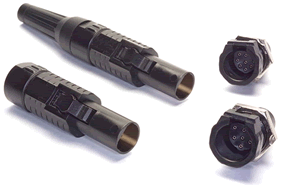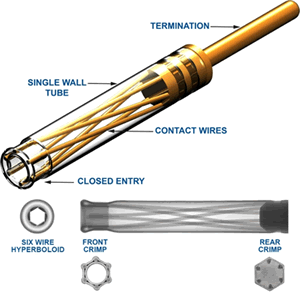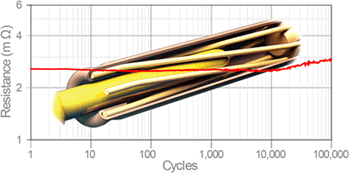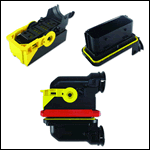Modern Hyperboloid Contacts for Circular I/O Connectors
When choosing modern hyperboloid contacts for circular I/O connectors, the specific requirements of the application are key considerations.

QA Technology’s IDO2 Series
Circular connectors are ubiquitous in medical electronics, instrumentation, and military and aerospace equipment. The round configuration lends itself to input/output applications that see frequent mating and un-mating. Plug and receptacle alignment is intuitive to enhance ease of use. Polarization and keying variations are also easily incorporated, so similar connectors can be used on the same panel without confusion. Modern circular connector designs lend themselves to convenient quick-latching systems that do not require tools or cumbersome screw-on retention collars and eliminate the possibility of unintentional de-mating.
Ergonomics has definitely played a big role in the growing use of circular I/O connectors. Circular connectors are often contoured to fit the hand, please the eye, and provide audible and visual feedback to the user to confirm proper mating. There’s nothing nicer than a nice sharp “click” when the connector is properly mated.
Contact Density and Engagement/Separation Force
When choosing the contact system for a circular I/O connector, the specific requirements of the application need to be kept in mind. A growing number of circular connector applications require a high number of mated lines without increased connector size or a change in the ergonomics or functionality. As in all electronic devices, space availability is decreasing and density is increasing, but as the line count goes up, so does the force to mate the contacts. No one likes a connector that becomes a two-handed operation because the mating force is too great, or one where the nice crisp click of the latch can’t be heard (or even felt) because so much force was required to mate the connector.
Most circular connectors for this type of application utilize conventional bifurcated screw machine contacts, plated with precious metal. The engagement/separation force for a typical screw-machined, gold-plated, signal contact (size 23) is about 141gf (5ozf) per contact. So for a connector with 14 contacts, the force to mate the connector includes almost 2kgf (4.3lbf) just to engage and separate the contacts. The friction of the latching system and any misalignment adds to the mating force required. Higher line counts require even more force, which may interfere with the functionality of the connector. Modern hyperboloid contacts have reduced engagement forces, about 40% lower than conventional contacts.
Hyperboloid Contacts
Hyperboloid socket contacts use a “basket” or “nest” of gold-plated, spring-contact wires to make contact with the mating pin at multiple locations. Hyperboloid contacts have a long history of use in demanding military/aerospace applications where their resistance to shock and vibration, low mating force, and high cycle life have been well established. On the downside, traditional hyperboloid contacts have a reputation for being larger in diameter than more conventional screw-machined contacts, which presents a packaging problem in high-density connectors. They also have a reputation for being higher-priced than conventional contacts.
Solving the Density Problem

Design model and X-ray of QA’s integraMate ICS Series
By using a single wall tube to support the contact wires and a closed entry for improved alignment, the new generation of hyperboloid contacts can now be made 30% smaller in diameter to produce form factors that are similar to the best available screw-machined contacts. Nice tight contact patterns can be produced up to the limits of the insulator molding technology and the electrical requirements.
The hyperboloid contact’s low engagement/separation force can now be fully exploited to increase the number of mated lines, while maintaining the tactile feel and functionality of the connector. The sweet “click” upon mating is retained, and the line count goes up. With this new generation of hyperboloid contacts, a 78-position circular connector with 2A-rated signal contacts will only need 2.45 Kgf (5.4lbf) to be mated. This is well within the comfort range of even the smallest technician and won’t impede tactile or audible feedback or risk inadvertent partial mating or unintentional de-mating. The engagement separation force of the smaller sizes of this new generation of hyperboloid contact are so low (about 32gf), they can be considered for use as a low-force alternative to complicated ZIF (zero insertion force) connectors.
An Affordable Alternative
The simplified design of today’s hyperboloid socket lessens the price gap that existed between gold-plated screw-machined contacts and traditional hyperboloid contacts. The entire surface of a screw-machined contact is usually plated with the same protective thickness of gold. With the new-style hyperboloid socket contacts, the only surfaces that need to be plated are the small-diameter contact wires, significantly reducing costs. The design of the new generation of hyperboloid contacts has also been optimized for high-speed assembly, which further reduces the cost delta with screw-machined contacts and allows for the use of corrosion-resistant stainless steel in areas where electrical conductivity is not required.
Meeting Design Life Goals
Equipment designers, especially those of medical instruments, now find that for many applications, the real-world number of mating cycles for the connectors (over the instrument’s design life) exceeds the durability recommended by the manufacturer. For some equipment, a seven-year design life can mean I/O connectors that mate up to 20,000 times. For many plastic connector systems, the housing and latching system is not the life-limiting feature; it’s the traditional contact system within the connector.
As the protective plating is inevitably worn on the contact surfaces, resistance begins to change, discontinuities can appear, and the connections can become more susceptible to environmental stressors; reliability begins to suffer. Good-quality screw-machined contacts with adequate plating schedules for environmental protection are often rated for up to 5,000 mating cycles. If the application requires 20,000 reliable cycles, this can be a problem. Either the cycle life needs to be compromised or a more robust contact system needs to be used.
The new generation of hyperboloid contacts changes this equation. The contact wire arrangement used in the hyperboloid socket provides multiple points of contact 360° around the pin to maintain secure connection without the need for high contact forces. For screw-machined contacts, the relatively high normal force required for stability

Resistance graph
is concentrated on a limited number of points between the pin and socket, making them more susceptible to wear. For hyperboloid contacts, the combination of lower contact force, thicker plating, and the smooth surface of the drawn spring wires results in lower wear. Low-level contact resistance measurements of more than 100,000 cycles show changes of less than 2.0 milliohms.
Hyperboloid contacts are rated for up to 100,000 cycles, so a 20,000 mating durability requirement for the I/O connector is not a daunting challenge.
When considering high-density connector designs, the advantages of the modern hyperboloid contact system include low forces, cost advantages, and higher mating life.
Learn more about contact technology at QA Technology Company Inc.





